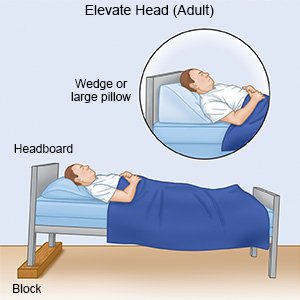Facial Contusion
Medically reviewed by Drugs.com. Last updated on Apr 6, 2025.
What is a facial contusion?
A facial contusion is a bruise that appears on your face after an injury. A bruise happens when small blood vessels tear but skin does not. Blood leaks into nearby tissue, such as soft tissue or muscle.
What increases my risk for a contusion?
- A disorder that makes you bleed more easily
- Kidney or liver disease, or an infection
- Medicines such as blood thinners or certain over-the-counter medicines and herbal medicines
- Weakened skin and muscles from older age or nutrition problems
What are the signs and symptoms of a facial contusion?
- An area that may be black, blue, red, or darker than the skin around it
- Pain that increases when you touch the bruise or move part of your face near the bruise
- Swelling, bruising, or a lump at the site of the bruise or near it
- Stiffness or problems moving the bruised area
How is a facial contusion diagnosed?
Your healthcare provider may ask about any injuries, infections, or bleeding problems you had in the past. Your provider will check the skin over the injured area. Your provider may touch it to see where it hurts. Your provider may also check for problems you may have when you move your bruised area. You may also need any of the following:
- Blood tests may be used to check for blood disorders or to see how long it takes for your blood to clot.
- Ultrasound pictures may show how deep the bruise is and if you have any other injuries.
- MRI pictures may show if a hematoma (pooling of blood) has started to form. You may be given contrast liquid to help the pictures show up better. Tell the healthcare provider if you have ever had an allergic reaction to contrast liquid. Do not enter the MRI room with anything metal. The MRI machine uses a powerful magnet. Metal can cause serious injury from the magnet. Tell the healthcare provider if you have any metal in or on your body.
How is a facial contusion treated?
A contusion may heal without any treatment. The bruise may become lighter or change to green or yellow as it heals. Treatment depends on the part of your body that is injured, and how serious your injury is. You may need any of the following:
- Medicine may be needed to treat or prevent pain or swelling.
- Aspiration is a procedure to drain pooled blood in your muscle. This prevents increased pressure in the muscle.
- Surgery may be done to repair a tear in the muscle or relieve pressure in the muscle caused by swelling.
What can I do to help my facial contusion heal?
- Rest the area around the bruise, or use it less than usual.
- Apply ice to decrease swelling and pain. Ice may also help prevent tissue damage. Use an ice pack, or put crushed ice in a plastic bag. Cover the bag with a towel and place it on your bruise for 15 to 20 minutes every hour or as directed.
- Elevate your head to help decrease pain and swelling. Use pillows, blankets, or rolled towels to keep your head elevated.

- Do not massage the area or put heating pads on the bruise right after your injury. Heat and massage may slow healing. Your healthcare provider may tell you to apply heat after several days. At that time, heat will start to help the injury heal.
How can I prevent a facial contusion?
- Use safety belts and child restraints in cars.
- Use safety helmets when you ride a bicycle or motorcycle.
- Use a mouth and face guard during sports.
When should I seek immediate care?
- You have a fever.
- You have watery, clear fluid draining from your nose.
- You have changes in your vision or eye appearance.
- You have changes or pain with eye movement.
- You have tingling or numbness in or near the injured area.
When should I call my doctor?
- You find a new lump in the injured area.
- Your symptoms do not improve with treatment.
- You have questions or concerns about your condition or care.
Care Agreement
You have the right to help plan your care. Learn about your health condition and how it may be treated. Discuss treatment options with your healthcare providers to decide what care you want to receive. You always have the right to refuse treatment. The above information is an educational aid only. It is not intended as medical advice for individual conditions or treatments. Talk to your doctor, nurse or pharmacist before following any medical regimen to see if it is safe and effective for you.© Copyright Merative 2025 Information is for End User's use only and may not be sold, redistributed or otherwise used for commercial purposes.
Further information
Always consult your healthcare provider to ensure the information displayed on this page applies to your personal circumstances.
